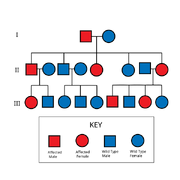Assessment |
Biopsychology |
Comparative |
Cognitive |
Developmental |
Language |
Individual differences |
Personality |
Philosophy |
Social |
Methods |
Statistics |
Clinical |
Educational |
Industrial |
Professional items |
World psychology |
Clinical: Approaches · Group therapy · Techniques · Types of problem · Areas of specialism · Taxonomies · Therapeutic issues · Modes of delivery · Model translation project · Personal experiences ·
Rubinstein-Taybi syndrome (also known as Broad Thumb-Hallux syndrome) is a condition characterized by short stature, moderate to severe mental retardation, distinctive facial features, and broad thumbs and first toes. Other features of the disorder vary among affected individuals. People with this condition have an increased risk of developing noncancerous and cancerous tumors, leukemia, and lymphoma. This condition is inherited in an autosomal dominant pattern and is uncommon occurring in an estimated 1 in 125,000 births.
Features of Rubinstein-Taybi syndrome[]
An isolated case was described in 1957 by Michail and Matsoukas. In 1963 Rubinstein and Taybi described a larger series of cases. Typical features of the disorder include:
- Broad thumbs and broad first toes
- Mental retardation
- Retarded height, bone age, small head
- Cryptorchidism in males
- Unusual faces - eyes, nose, palate
Genetics[]

Rubinstein-Taybi syndrome is inherited in an autosomal dominant fashion.
Mutations in the CREBBP gene cause Rubinstein-Taybi syndrome. The CREBBP gene makes a protein that helps control the activity of many other genes. The protein, called CREB binding protein, plays an important role in regulating cell growth and division and is essential for normal fetal development. If one copy of the CREBBP gene is deleted or mutated, cells make only half of the normal amount of CREB binding protein. A reduction in the amount of this protein disrupts normal development before and after birth, leading to the signs and symptoms of Rubinstein-Taybi syndrome.
Mutations in the EP300 gene are responsible for a small percentage of cases of Rubinstein-Taybi syndrome. These mutations result in the loss of one copy of the gene in each cell, which reduces the amount of p300 protein by half. Some mutations lead to the production of a very short, nonfunctional version of the p300 protein, while others prevent one copy of the gene from making any protein at all. Although researchers do not know how a reduction in the amount of p300 protein leads to the specific features of Rubinstein-Taybi syndrome, it is clear that the loss of one copy of the EP300 gene disrupts normal development.
References[]
- Coupry I, Monnet L, Attia AA, Taine L, Lacombe D, Arveiler B., Analysis of CBP (CREBBP) gene deletions in Rubinstein-Taybi syndrome patients using real-time quantitative PCR. Hum Mutat. 2004 Mar;23(3):278-84. PMID 14974086
- Michail J, Matsoukas J, Theodorou S [Arched, clubbed thumb in strong abduction-extension & other concomitant symptoms.] Rev Chir Orthop Reparatrice Appar Mot. 1957 Apr-Jun;43(2):142-6. PMID 13466652
- Rubinstein JH, Taybi H, Broad thumbs and toes and facial abnormalities. A possible mental retardation syndrome. Am J Dis Child. 1963 Jun;105:588-608. PMID 13983033
External links[]
- RTS - Rubinstein-Taybi Syndrome - A site devoted to the families and people diagnosed with Rubinstein-Taybi Syndrome.
- Rubinstein-Taybi syndrome - eMedicine Article
- History of RTS by J.H. Rubinstein.
- fr:Syndrome de Rubinstein-Taybi
| This page uses Creative Commons Licensed content from Wikipedia (view authors). |